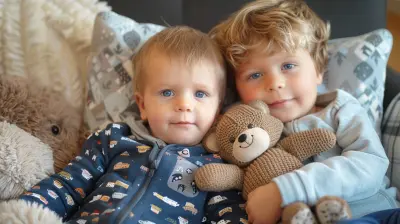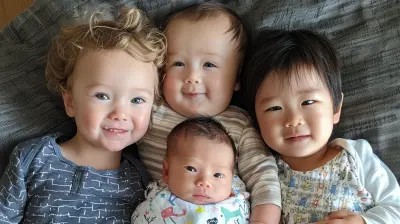Managing Your Child’s Attachment Issues: What to Do When They Won’t Leave Your Side
1 December 2024
Are you navigating the emotional rollercoaster of a clingy child who just won’t let you out of their sight? Maybe it’s gotten to the point where you can’t even cross the room without them following behind like your personal little shadow. If this sounds all too familiar, don’t panic—you're not alone! Many parents experience phases where their child struggles with attachment issues, making separation feel like a mini soap opera unraveling right in your living room.
Thankfully, with a little patience, some useful tactics, and understanding, you can help your child feel secure even when you’re not just an arm’s distance away. Let’s dive into the heart of what’s going on with that clingy behavior and what you can do to work through it.

Understanding Your Child’s Attachment Issues
Before we get into the solutions, it's important to first grasp what attachment issues are and why they’re happening. Attachment is an emotional bond that starts developing from the day your child is born. It's their trust in you as their primary caregiver, and it influences their future relationships, emotional regulation, and even their independence.In the early days, attachment behaviors like following you everywhere and crying when you leave are pretty typical. Babies and toddlers rely heavily on their parents for safety and comfort. But when these behaviors extend past the toddler years, or happen in a way that seems excessively heightened, it could indicate a deeper attachment issue that needs addressing.
But Wait, Is It Normal?
Yes, clinginess is almost always a normal part of development, especially at certain stages like infancy and toddlerhood. However, when it starts to feel like it’s interfering with your or your child’s ability to engage in typical daily activities, it might be time to look closer at the issue.Your child might resist going to school, refuse to engage with peers, or have difficulty falling asleep alone at night. That’s when attachment concerns can start to raise red flags. But don't worry—with some conscious effort, it is possible to help your child feel secure without being glued to you 24/7.

Types of Attachment Disorders
When we're talking about children who experience intense, unrelenting attachment issues, there are a couple of official terms that might come up:1. Separation Anxiety Disorder (SAD):
Separation anxiety is common in younger children (typically appearing between 6 months and 3 years). But if it persists into the school years and beyond, it might be something more significant, like Separation Anxiety Disorder. Children with SAD might have extreme fears about being away from their parents, often leading to emotional meltdowns or physical symptoms such as stomachaches or headaches.2. Reactive Attachment Disorder (RAD):
This is a more severe form of attachment issue, stemming from neglect or trauma in early life. Children with RAD may struggle to form healthy attachments, which can manifest as emotional detachment, difficulty trusting others, or in rarer cases, excessive clinginess. If your child's behaviors seem extreme or out of the ordinary, it’s always best to consult a professional for further guidance.Now that you know what's going on, let’s focus on what you can do about it!

What to Do When Your Child Won’t Leave Your Side
Managing attachment issues can feel like walking a tightrope. You want your child to feel safe and loved, but at the same time, you want to encourage independence. Here’s a toolkit of strategies you can start implementing today.1. Acknowledge Their Feelings First
No matter how frustrated or exhausted you might feel, always start by validating your child's emotions. If they’re feeling anxious or scared, labeling and acknowledging that can go a long way. Say something like, “I know you're feeling worried when Mommy leaves the room, and that’s okay. But I’ll be right back.”By addressing their emotions, you’re helping them understand that their feelings are normal, rather than something to be ashamed of. This sets the stage for further growth.
2. Practice Gradual Separation
Throwing your child into a situation where they have to be away from you for extended periods can backfire. Instead, try gradual separation. This means starting with small moments of separation and slowly increasing the time as they become more comfortable.For example, you could step into another room for just a few minutes, then slowly build up to longer periods. When they see that you always return when you say you will, they’ll begin to trust that they’ll be okay while you’re gone.
3. Establish Routines
Routines create a sense of security. When children know what to expect, it alleviates some of the anxiety surrounding separation. Whether it’s dropping them off at preschool or leaving them with a babysitter, create a short, sweet routine for goodbyes.This could be as simple as a hug, kiss, or a little phrase like, “I’ll be back soon, and we’ll read your favorite book together.” Stick to that routine, so your child knows exactly what to expect. Over time, this predictability helps them feel more secure.
4. Offer Transitional Objects
A transitional object, such as a favorite stuffed animal, blanket, or even a piece of your clothing, can serve as a comforting reminder of you when you're not physically present. These items provide a sense of security and help ease the stress of separation.Allowing them to keep something that smells like you (your scarf, for example) can be even more comforting, as smell is a powerful trigger for memory and reassurance.
5. Encourage Independence Through Play
Children develop confidence through exploration and play. When you encourage your child to engage in independent play, you’re reinforcing the idea that they’re capable even when you’re not right next to them.You can start by being in the same room but encourage independent activities like puzzles, coloring, or playing with blocks. Slowly move out of the room for short periods, letting them know you’re still nearby if they need you. This builds both self-confidence and independence over time.
6. Be Consistent
Children need consistency to feel secure. Stick to a consistent schedule as much as possible, especially during transitions such as daycare drop-offs, bedtime, or when you need to leave the house. If your child knows what to expect, they’ll be less likely to panic when faced with brief separations.Consistency also applies to your reactions. If you always respond to their clinginess by giving in and carrying them everywhere, they’ll keep expecting the same. Instead, respond in a way that supports their independence without dismissing their feelings.
7. Don't Sneak Away
Tempting as it may be to slip out unnoticed, it can do more harm than good. When children turn around and realize you’re gone without saying goodbye, it can make their anxiety around separation even worse. It can also lead to trust issues—they might think you’ll disappear at any moment.Instead, always say goodbye and reassure them that you’ll return. Keep it brief and positive—lingering goodbyes can sometimes heighten their anxiety.
8. Encourage Socialization and New Experiences
Getting your child comfortable around other people is a great way to ease attachment issues. Encourage playdates, interactions with family members, or leaving them with a trusted babysitter for short periods. Positive social experiences will help them feel more secure in environments where you’re not the only source of comfort.It’s also beneficial to gradually introduce new environments that don’t involve immediate separation, like visiting a park or library, where they can explore while still knowing you’re nearby.
9. Be Patient and Give It Time
Lastly, but perhaps most importantly, be patient. These kinds of attachment issues don’t resolve overnight. It’s a gradual process, and it might involve a few steps backward before you truly move forward. Your child thrives on your love, care, and patience—allow them the space to grow at their own pace.
When Should You Seek Professional Help?
While most attachment issues are part of normal development and can be managed with strategies like these, there are instances when you might need professional support. If your child’s clinginess:- Continues beyond an age-appropriate stage,
- Interferes with their ability to socialize or engage in normal activities like school,
- Seems to stem from deeper emotional issues (such as trauma or neglect), or
- Causes significant distress or physical symptoms like nausea, headaches, or emotional meltdowns,
...it may be worth consulting a child psychologist or counselor who specializes in attachment disorders. Early intervention can make a world of difference in helping your child build healthier attachment patterns.
Final Thoughts
It can feel both overwhelming and heartbreaking when your child won’t let you out of their sight, but remember—you’re not alone in this journey. Attachment issues are something many parents face, and with a combination of empathy, gradual separation, consistency, and patience, you can help your little one develop the confidence to spread their wings.Don’t forget, though. It’s a process—and a winding one at that. There will be days when progress feels impossible, and days when small victories remind you that you're on the right track. Keep going; you’ve got this!
all images in this post were generated using AI tools
Category:
Parenting ChallengesAuthor:

Max Shaffer
Discussion
rate this article
14 comments
Kalani Lynch
Encourage independence gradually; patience is key.
March 10, 2025 at 5:08 PM

Max Shaffer
Thank you for your insight! Gradual independence is indeed crucial, and patience helps create a safe environment for children to explore on their own.
Merida McAndrews
Great insights! It’s essential to provide a safe space for your child while gradually encouraging independence. Consistent routines and positive reinforcement can work wonders in easing attachment challenges. Thank you for sharing!
February 5, 2025 at 5:08 AM

Max Shaffer
Thank you for your thoughtful comment! I completely agree—creating a safe space and using positive reinforcement are key strategies in helping children develop independence.
Declan McDonald
Embrace their need for closeness as a chance to build trust. Every step towards independence is a victory in love!
January 26, 2025 at 3:23 AM

Max Shaffer
Thank you for your insightful comment! Embracing closeness can indeed foster trust and support their journey toward independence.
Vex Martinez
Navigating attachment issues requires patience and empathy. Create a secure environment that encourages independence by gradually introducing separations, even short ones. Acknowledge and validate your child's feelings, reinforcing that it's okay to feel anxious. Empower them with coping strategies, fostering resilience while strengthening your bond through trust and understanding.
January 20, 2025 at 4:25 PM

Max Shaffer
Thank you for your insightful comment! Patience and empathy are indeed key in addressing attachment issues, and creating a secure environment is essential for fostering independence. Your suggestions on validating feelings and introducing gradual separations are valuable strategies for parents.
Maxine Weber
Is their clinginess a hidden cry for help?
January 16, 2025 at 4:31 PM

Max Shaffer
Yes, clinginess can often signal deeper emotional needs. It's important to explore the underlying causes and provide reassurance.
Ellie McFarlin
This article resonates deeply with my journey as a parent. Understanding my child's attachment issues helped me approach their needs with patience and empathy, fostering a healthier bond over time. Thank you!
January 13, 2025 at 5:58 AM

Max Shaffer
Thank you for sharing your experience! I'm glad the article resonated with you and supported your journey as a parent. Your patience and empathy are truly commendable!
Karly Coleman
Thank you for this insightful article on managing attachment issues. It’s reassuring to know that many parents face similar challenges. Your practical tips offer a helpful approach to fostering independence while respecting a child’s need for closeness. I look forward to implementing these strategies with my little one!
January 5, 2025 at 5:19 AM

Max Shaffer
Thank you for your kind words! I’m glad you found the article helpful, and I wish you the best in implementing these strategies with your child.
Cynthia Rios
Understanding your child's attachment needs fosters security; gradual independence builds confidence. Patience and communication are key to progress.
December 26, 2024 at 4:44 AM

Max Shaffer
Thank you for your insightful comment! I completely agree that fostering security through understanding attachment needs and encouraging gradual independence can significantly boost a child's confidence. Patience and open communication truly are essential in this process.
Selkie Baxter
Navigating your child's attachment can feel like a constant game of shadow tag. Embrace the closeness, but gently encourage independence; it’s a balancing act that fosters both security and confidence in their growing world.
December 20, 2024 at 5:36 PM

Max Shaffer
Thank you! It truly is a delicate balance between nurturing attachment and fostering independence—both are essential for your child's development.
Jenna Newton
Understanding and addressing your child’s attachment issues requires patience and empathy. Gradual separation, reassurance, and fostering independence can help cultivate their confidence and emotional resilience.
December 18, 2024 at 5:25 PM

Max Shaffer
Thank you for your insightful comment! Patience and empathy are indeed essential in supporting a child's emotional growth and fostering independence.
Jessica Whitley
Guess I’m now a human backpack!
December 12, 2024 at 3:46 AM

Max Shaffer
I understand the struggle! It's all about finding a balance and helping them feel secure while encouraging independence. You’ve got this!
Candace McKee
Remember, your presence is a comforting anchor; patience will help them feel secure.
December 10, 2024 at 3:48 AM

Max Shaffer
Thank you for your thoughtful insight! Your support truly makes a difference in fostering secure attachments.
Rocco McAleer
This article offers valuable strategies for navigating attachment issues, but it could further explore the underlying emotional needs driving clinginess. A deeper understanding of attachment theory could empower parents to foster healthy independence while maintaining connection.
December 3, 2024 at 3:29 PM

Max Shaffer
Thank you for your insightful comment! I appreciate your suggestion to delve deeper into the emotional needs behind clinginess and attachment theory, and I will consider this for future discussions. Your feedback is invaluable in enhancing our understanding of fostering healthy independence in children.
Reagan Summers
Attachment issues in children can be challenging, but understanding their roots is essential. Validate your child's feelings, gradually encourage independence through small separations, and establish a consistent routine. Engaging in play therapy can also help them express emotions. Professional guidance may be beneficial for deeper issues.
December 1, 2024 at 5:35 PM

Max Shaffer
Thank you for your insightful comment! Understanding and addressing attachment issues is crucial for fostering independence and emotional well-being in children. Your suggestions for validation, gradual separation, and professional guidance are spot on!
MORE POSTS

The Stress of Potty Training: Overcoming Your Child’s Resistance

Childproofing Your Stairs: Best Practices for Safety

The Role of Gratitude in Fatherhood: A Practice for the Busy Dad

Tandem Nursing: Breastfeeding a Toddler and a Newborn

Understanding and Encouraging Toddler Compassion

Mindful Parenting for a More Peaceful Bedtime Routine

Preparing for a New Sibling While Staying Connected to Your First Child

Finding Balance: Work, Parenting, and Self-Care

Potty Training in Public: How to Handle Outings Like a Pro